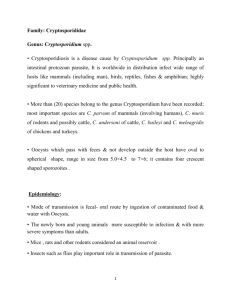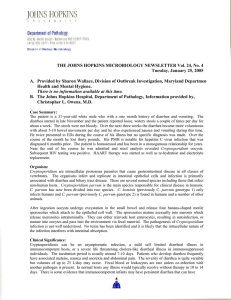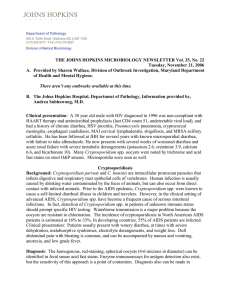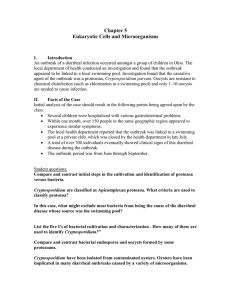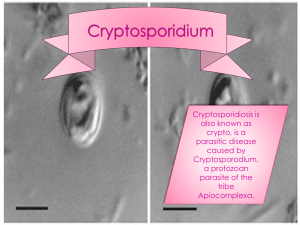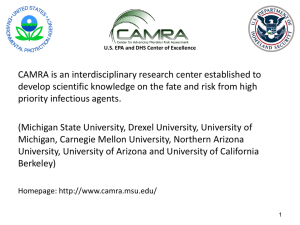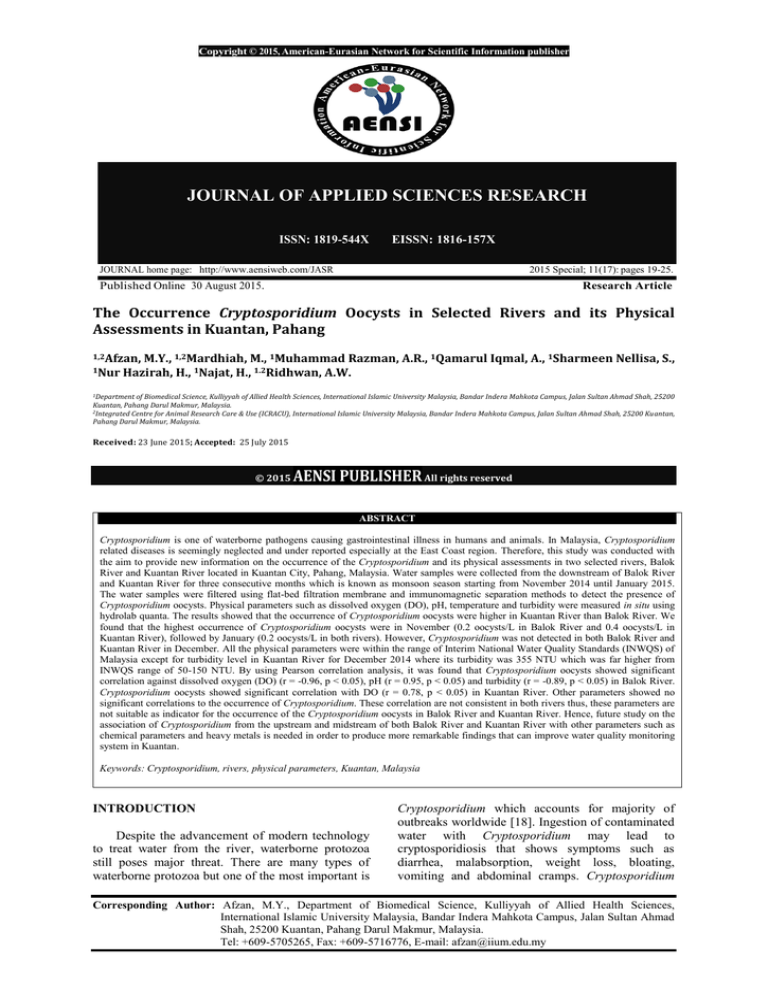
Copyright © 2015, American-Eurasian Network for Scientific Information publisher
JOURNAL OF APPLIED SCIENCES RESEARCH
ISSN: 1819-544X
EISSN: 1816-157X
JOURNAL home page: http://www.aensiweb.com/JASR
2015 Special; 11(17): pages 19-25.
Published Online 30 August 2015.
Research Article
The Occurrence Cryptosporidium Oocysts in Selected Rivers and its Physical
Assessments in Kuantan, Pahang
1,2Afzan,
1Nur
M.Y., 1,2Mardhiah, M., 1Muhammad Razman, A.R., 1Qamarul Iqmal, A., 1Sharmeen Nellisa, S.,
Hazirah, H., 1Najat, H., 1.2Ridhwan, A.W.
1Department
of Biomedical Science, Kulliyyah of Allied Health Sciences, International Islamic University Malaysia, Bandar Indera Mahkota Campus, Jalan Sultan Ahmad Shah, 25200
Kuantan, Pahang Darul Makmur, Malaysia.
2Integrated Centre for Animal Research Care & Use (ICRACU), International Islamic University Malaysia, Bandar Indera Mahkota Campus, Jalan Sultan Ahmad Shah, 25200 Kuantan,
Pahang Darul Makmur, Malaysia.
Received: 23 June 2015; Accepted: 25 July 2015
© 2015
AENSI PUBLISHER All rights reserved
ABSTRACT
Cryptosporidium is one of waterborne pathogens causing gastrointestinal illness in humans and animals. In Malaysia, Cryptosporidium
related diseases is seemingly neglected and under reported especially at the East Coast region. Therefore, this study was conducted with
the aim to provide new information on the occurrence of the Cryptosporidium and its physical assessments in two selected rivers, Balok
River and Kuantan River located in Kuantan City, Pahang, Malaysia. Water samples were collected from the downstream of Balok River
and Kuantan River for three consecutive months which is known as monsoon season starting from November 2014 until January 2015.
The water samples were filtered using flat-bed filtration membrane and immunomagnetic separation methods to detect the presence of
Cryptosporidium oocysts. Physical parameters such as dissolved oxygen (DO), pH, temperature and turbidity were measured in situ using
hydrolab quanta. The results showed that the occurrence of Cryptosporidium oocysts were higher in Kuantan River than Balok River. We
found that the highest occurrence of Cryptosporidium oocysts were in November (0.2 oocysts/L in Balok River and 0.4 oocysts/L in
Kuantan River), followed by January (0.2 oocysts/L in both rivers). However, Cryptosporidium was not detected in both Balok River and
Kuantan River in December. All the physical parameters were within the range of Interim National Water Quality Standards (INWQS) of
Malaysia except for turbidity level in Kuantan River for December 2014 where its turbidity was 355 NTU which was far higher from
INWQS range of 50-150 NTU. By using Pearson correlation analysis, it was found that Cryptosporidium oocysts showed significant
correlation against dissolved oxygen (DO) (r = -0.96, p < 0.05), pH (r = 0.95, p < 0.05) and turbidity (r = -0.89, p < 0.05) in Balok River.
Cryptosporidium oocysts showed significant correlation with DO (r = 0.78, p < 0.05) in Kuantan River. Other parameters showed no
significant correlations to the occurrence of Cryptosporidium. These correlation are not consistent in both rivers thus, these parameters are
not suitable as indicator for the occurrence of the Cryptosporidium oocysts in Balok River and Kuantan River. Hence, future study on the
association of Cryptosporidium from the upstream and midstream of both Balok River and Kuantan River with other parameters such as
chemical parameters and heavy metals is needed in order to produce more remarkable findings that can improve water quality monitoring
system in Kuantan.
Keywords: Cryptosporidium, rivers, physical parameters, Kuantan, Malaysia
INTRODUCTION
Despite the advancement of modern technology
to treat water from the river, waterborne protozoa
still poses major threat. There are many types of
waterborne protozoa but one of the most important is
Cryptosporidium which accounts for majority of
outbreaks worldwide [18]. Ingestion of contaminated
water with Cryptosporidium may lead to
cryptosporidiosis that shows symptoms such as
diarrhea, malabsorption, weight loss, bloating,
vomiting and abdominal cramps. Cryptosporidium
Corresponding Author: Afzan, M.Y., Department of Biomedical Science, Kulliyyah of Allied Health Sciences,
International Islamic University Malaysia, Bandar Indera Mahkota Campus, Jalan Sultan Ahmad
Shah, 25200 Kuantan, Pahang Darul Makmur, Malaysia.
Tel: +609-5705265, Fax: +609-5716776, E-mail: afzan@iium.edu.my
20
Afzan, M.Y. et al, 2015 /Journal Of Applied Sciences Research 11(17), Special, Pages: 19-25
can survive in extreme environment and has low
infectious dose which requires only small number to
replicate and cause adverse health effects in human
[3].
Studies showed that the oocysts of
Cryptosporidium can survive in chlorine due to their
thick protective cell wall of the oocysts. The
vulnerable groups to be infected by Cryptosporidium
are young children and immunocompromised
individuals.
Physical assessment is the study about water
properties such as biological oxygen demand (BOD),
pH, total suspended solids, temperature, alkalinity,
dissolved oxygen and salinity [43]. These parameters
are important to determine the water quality before
the water is distributed for industries, agriculture and
domestic use. It was found that the temperature is a
main factor that can affect the oocyst of
Cryptosporidium. The oocysts tend to die at high
temperature [33] and increase in number at low
temperature
[24].
The
occurrence
of
Cryptosporidium also increases with the increasing
of turbidity of water [24].
There are few studies done on prevalence of
intestinal protozoa infections on water samples in
Malaysia. For two recreational rivers in Selangor, the
occurrences of C. parvum were higher in Sungai
Congkak (10% or 3/30 of water samples) rather than
Sungai Batu (3.3% or 1/30 of water samples) [3].
Study done by Lee et al. [20] found that water
samples from Kemensah (100 %; 9/9 samples) and
Kuala Pangsun (66.6 %; 6/9 samples) were positive
with Cryptosporidium oocysts.
In Malaysia, the studies regarding the presence
of waterborne parasites and physical properties of
rivers have mostly been done in Selangor but, there
is no study done yet in Kuantan. Therefore, the study
attempts
to
identify
the
occurrence
of
Cryptosporidium and its association with physical
properties of two selected rivers, Balok River and
Kuantan River in Kuantan, Pahang, Malaysia.
2. Objectives:
This study was conducted with the aim to
provide a new information on the occurrence of the
Cryptosporidium and its physical assessments in two
selected rivers, Balok River and Kuantan River
located in Kuantan, Pahang, Malaysia.
Materials and Methods
3.1 Study Area:
The present study was carried out in Kuantan,
Pahang (3° 49’00”N 103˚20’00”E). Kuantan is
located in the east coast of Peninsular Malaysia and it
is one of the cities with a fast growing population. In
2010, according to Department of Statistics
Malaysia, Kuantan has a population of approximately
461,000, making it the 9th biggest city in Malaysia.
Its fast growth in industrialization and development
for the past 10 years was the catalyst that created the
tremendous increase in its population. Besides,
Kuantan is hot and humid and receive rainfall
throughout the year.
3.2 Sample collection:
The samples were collected from two selected
rivers namely Balok River and Kuantan River. Balok
River flows through the industrialized area in
Gebeng, Kuantan while Kuantan River flows through
densely residential and commercial area in Kuantan
city. There are fishing villages situated at the estuary
of both rivers. The downstream area in both rivers
(Figure 1 and Figure 2) are selected as the sampling
sites due to human activities such as fishing,
swimming and tourism. Water samples from both
rivers were collected once each month for three
consecutive months from November 2014 until
January 2015.
Fig. 1: The site of water samples collections at Balok River.
21
Afzan, M.Y. et al, 2015 /Journal Of Applied Sciences Research 11(17), Special, Pages: 19-25
Fig. 2: The site of water samples collections at Kuantan River.
3.4 Filtration, Elution and Concentration for
Cryptosporidium oocysts:
Filtration was performed by filtering ten litres of
water samples using the flat-bed membrane filtration
technique. The Whatman® Sterile nitrocellulose
membrane with 1.2 µm pore size was used to filter
the water samples and the eluate was concentrated
and purified from debris using the immunomagnetic
separation (IMS) technique (Dynabeads GC-Combo,
Invitrogen USA) according to manufacturers’
instructions. The IMS procedure and detection
method for Cryptosporidium were performed
according to the US EPA Method 1623. Briefly, the
method involves adding magnetic beads labeled with
anti-Cryptosporidium to the samples for antibodyantigen reactions. The oocysts are bound to the
magnetic beads and separated from the debris after
being placed at magnetic particle concentrator. After
removing supernatant containing debris, the
suspension containing purified oocysts was
transferred to a new tube.
3.5 Microscopy examination of Cryptosporidium
oocysts:
The 50µl of purified oocysts were stained with a
commercial fluorescein isothiocyanate (FITC)labelled monoclonal antibody kit specific to
Cryptosporidium oocysts (Cellabs, Australia)
according to the manufacturer’s instructions. These
slides were evaluated using epifluorescence
microscope (magnification x400). The presence of
Cryptosporidium was calculated as; number of
(oo)cysts per liter = number of oocysts on slide
(contained by 50 μL)/10 L.
3.6 Water physical parameters measurement:
For physical analysis, four physical parameters
of water which were dissolved oxygen (DO), pH,
temperature, and turbidity were measured in situ
using the multiprobe water quality equipment
(Hydrolab Quanta, Germany). The Interim National
Water Quality Standards (INWQS) which is the
standard for the vital level of parameters to
determine the safety level of surface waters in
Malaysia [11] and it is used as the benchmark for
parameters obtained from this study.
3.7 Statistical Analysis:
The Statistical Package for Social Sciences
software for Windows (SPSS Inc., Chicago, IL,
USA) version 17.0 was used to analyze the data. The
linear regression analysis was used to evaluate the
association between the number of oocyst of
waterborne parasites and physical parameters. The
values of p<0.01 and p<0.05 were considered as
statistically significant.
4. Results:
4.1 Occurrence of Cryptosporidium oocysts in water
samples:
The data of Cryptosporidium is summarized in
Table 1. Kuantan River has higher occurrence of
Cryptosporidium as compared to Balok River. For
Balok River, Cryptosporidium oocysts were detected
in November and January with 0.2 oocysts per Liter
for both months.
For Sungai Kuantan, Cryptosporidium oocysts
were detected with 0.4 oocysts per Liter in
November and 0.2 oocysts per Liter in January. No
protozoa detected in December for both rivers.
4.2 Physical Parameters:
The data for physical parameters is presented in
Table 1. Both Balok River and Kuantan River
showed slightly acidic condition (pH 5.5-6.6) except
for Kuantan River which was slightly alkaline (pH
7.35) at 24.6–26.9 ºC in January. Balok River and
Kuantan River contain DO ranging from 3.16-4.87
mg/L. The highest DO was measured at Balok River
in January (4.87 mg/L) and the lowest also at Balok
River in November (3.16 mg/L). Kuantan River
appeared to have higher turbidity each month than
Balok River.
4.3 Correlation between the occurrence of
Cryptosporidium oocysts and physical parameters of
water:
Based on Table 2, Cryptosporidium oocysts
obtained from Balok River showed significant
correlation against DO (r = -0.96, p < 0.05), pH (r =
22
Afzan, M.Y. et al, 2015 /Journal Of Applied Sciences Research 11(17), Special, Pages: 19-25
0.95, p < 0.05) and turbidity (r = -0.89, p < 0.05).
Cryptosporidium oocysts obtained from Kuantan
River only showed significant correlation with DO (r
= 0.78, p < 0.05). The oocysts do not show any
correlation with other parameters.
Table 1: The occurrence of Cryptosporidium oocysts per liter of water and physical parameters of water samples from Balok River and
Kuantan River in November, December and January.
BALOK RIVER
No.Oocysts/L
Dissolve Oxygen (mg/L)
pH
Temperature (ºC)
Turbidity
(NTU)
NOVEMBER 2014
0.20
3.16
5.97
24.9
76.5
DECEMBER 2014
0.00
4.87
5.51
25.1
135
JANUARY 2015
0.20
3.66
6.19
26.82
26.8
No.Oocysts/L
Dissolve Oxygen (mg/L)
0.40
4.30
0.00
3.39
0.20
4.48
KUANTAN RIVER
pH
NOVEMBER 2014
6.19
DECEMBER 2014
6.61
JANUARY 2015
7.35
5. Discussion:
In Malaysia, very few studies done on
waterborne protozoa obtained from rivers [3,20,1]
and most of their studies only focused on waterborne
parasites in rivers located at Selangor. Thus, this
study provides information about the occurrence of
Cryptosporidium in Balok River and Kuantan River
which are the two main rivers that flow in Kuantan.
We found that the occurrence of Cryptosporidium
oocysts in the downstream at Balok River and
Kuantan River are related with the industrial,
commercial and densely populated area as mentioned
by Azman et al. [3]. There are several fishing
villages in the downstream area at the river banks.
These villages are in poor hygienic condition as
effluents from houses flow directly into the river
without any water treatment. We found that illegal
dumping of more than a tonne of rubbish at the river
banks especially at the area surrounding the jetty.
The discharged effluents from the fishing villages
may contribute to the presence of oocysts and cysts
as mentioned by a previous study [8]. Many locals
spent their weekend at the downstream area of Balok
River and Kuantan River for fishing-related
activities. Some children also were spotted
swimming in both downstream areas. Shan et al.,
reported that fishing and swimming activities may
increase the risk of infection among the population
because waterborne protozoa can infect people
through direct contact with the contaminated river.
This trending is related to seasonal factor.
According to Malaysia Meteorological Department
(2014), December has the highest rainfall for
Kuantan annually. The runoff water can carry the
protozoa cysts and oocysts from the soil into the river
thus increasing its concentration [9] such as in
November but the absence of parasites in water
samples from Balok River and Kuantan River in
Temperature (ºC)
Turbidity
(NTU)
25.16
152
24.66
355
26.94
31.6
December is probably due to huge amount of runoff
water that can dilute the parasite concentration [19].
Towards the end of the rainy season in January, the
oocysts’ presence in water samples obtained from
both Balok River and Kuantan River is probably due
to a stagnant river flow and low volume of runoff
that caused accumulation of oocysts at the
downstream as similar finding by Azman et al., [3]
and Lee et al., [20].
Based on the Interim National Water Quality
Standards (INWQS) Malaysia, Balok River and
Kuantan river can be classified under Class III which
need extensive treatment have economic values and
contain tolerant species. The finding for dissolved
oxygen (DO) in both Balok and Kuantan River were
within the range of INWQS which is from 3-5
(mg/L). Balok River and Kuantan River showed
acidic properties except for Kuantan River in January
2015 which was slightly alkaline. The pH was higher
than the level set by INWQS for Class III river (pH
5-6). The turbidity level of both rivers is within the
range of INWQS (50-150 NTU) except for Kuantan
River in December 2014 where the turbidity level
reached 355 NTU. This could be due to heavy
rainfall in December (Malaysia Meteorological
Department, 2014) that brings huge amount of runoff
water from the upstream that contains silt and soil.
The turbidity level of both rivers in January 2015
was quite low as compared to the INWQS which was
probably due to the end of rainy season and big
reduction in runoff volume thus, lower concentration
of silt being washed into the river. Results from
Pearson Correlation analysis revealed that,
Cryptosporidium showed correlation with DO, pH
and turbidity in Balok River while in Kuantan River
it showed correlation with DO only. The oocysts
showed no correlations with other parameters. These
correlations are not consistent in both Balok River
23
Afzan, M.Y. et al, 2015 /Journal Of Applied Sciences Research 11(17), Special, Pages: 19-25
and Kuantan River thus; it does not express the true
associations between the occurrence of the
Cryptosporidium oocysts and the physical parameters
of water samples. This finding is similar with the
previous studies [3,30,20,1]. Thus, the results cannot
be generalized since every river contains its own
organisms and different level of pollution.
6. Conclusion:
This study provides new information regarding
the occurrence of Cryptosporidium in Kuantan,
Pahang, Malaysia as there has no study done in this
area yet. Poor hygiene and improper waste water
management in the downstream area of Balok River
and Kuantan River can contribute to the increase of
the occurrence of cryptosporidiosis and other waterrelated diseases. Sewage from the industries,
commercial and residential areas also contributed to
this problem. Due to possible health risk, both rivers
should be monitored regularly as well as other rivers
in Pahang, Malaysia by the authorities. Every citizen
must cooperate with local authorities in improving
river quality by cleaning up and most importantly the
public education via the river awareness
programmes. For future research, the upstream and
midstream water samples should be collected so that
the detailed data regarding the occurrence of
waterborne protozoa in Kuantan, Pahang, Malaysia
can be obtained. The chemical assessments and
heavy metal parameters of water samples are needed
so that the data on correlation between
Cryptosporidium from both Balok River and
Kuantan River with these parameters can be
acquired. Besides, molecular characterization also
needs to be done so that genotypes of
Cryptosporidium can be identified.
3.
4.
5.
6.
7.
8.
9.
10.
Acknowledgement
The authors are grateful to Majdina Mansor
from Centre for Languages and Pre-University
Academic Development, IIUM for proof reading and
useful support. The authors also express sincere
gratitude to the Ministry of Higher Education for
giving grant approval. This research work was
funded by the RAGS 13-010-0073 and FRGS FRGS
14-148-0389.
11.
References
12.
1.
2.
Ahmad, R.A., E. Lee, I.T.L. Tan, A.G.
Mohamad-Kamel, 1997. Occurrence of Giardia
cysts and Cryptosporidium oocysts in raw and
treated water from two water treatment plants in
Selangor, Malaysia. Water Research, 31(12):
3132-3136.
Anuar, T.S., M.K. Abdul Ghani, S.N. Azreen
M.S. Fatmah and M. Norhayati, 2013.
Blastocystis infection in Malaysia: Evidence of
waterborne and human-to-human transmissions
13.
among the Proto-Malay, Negrito and Senoi
tribes of Orang Asli. Parasites & Vectors, 6(40).
Azman, J., I. Init, W.W. Yusoff, 2009. Result
Filters. National Center for Biotechnology
Information. Retrieved October 18, 2014, from
http://www.ncbi.nlm.nih.gov/pubmed/20237443.
Baron, S., R.G. Yaeger, 1996. Protozoa:
Structure,
Classification,
Growth,
and
Development.
Baruch, A.C., J. Isaac-Renton, R.D. Adam,
1996. The molecular epidemiology of Giardia
lamblia: a sequence-based approach. Journal of
Infectious Diseases, 174(1): 233-236.
Betancourt, W.Q., J.B. Rose, 2004. Drinking
water treatment processes for removal of
Cryptosporidium and Giardia. Veterinary
parasitology, 126(1): 219-234.
Borowski, H., R. Thompson, T. Armstrong, P.
Clode, 2009. Morphological characterization of
Cryptosporidium parvum life-cycle stages in an
in vitro model system. Research Repository, 1:
14.
Castro-Hermida, J.A., I. García-Presedo, M.
González-Warleta,
M.
Mezo,
2010.
Cryptosporidium and Giardia detection in water
bodies of Galicia, Spain. Water research, 44(20):
5887-5896.
Cizek, A.R., G.W. Characklis, L.A. Krometis,
J.A. Hayes, O.D. Simmons, S. Di Lonardo, K.A.
Alderisio, M.D. Sobsey, 2008. Comparing the
partitioning
behavior
of
Giardia
and
Cryptosporidium with that of indicator
organisms in stormwater runoff. Water research,
42(17): 4421-4438.
Department of Statistics Malaysia, 2010.
Retrieved
January
20,
2015,
from
https://www.google.com/url?sa=t&rct=j&q=&es
rc=s&source=web&cd=2&ved=0CCUQFjAB&
url=https://www.statistics.gov.my/mycensus201
0/images/stories/files/Laporan_Kiraan_Permulaa
n2010.pdf&ei=gpmFVcC2H8XJuASV07mIBg
&usg=AFQjCNFYWkvLeDrJstuP0QUycriGjK.
DOE (Department of Environment Malaysia)
(2010). Malaysia environmental quality report.
Department of Environment, Ministry of Natural
Resources
Environment
Malaysia.
http://www.wepadb.
net/policies/law/malaysia/eq_surface.htm.
Accessed 10 Aug 2012.
Fayer, R., 2008. Cryptosporidium and
Cryptosporidiosis. Boca Raton, Florida: CRC
Press.
Fernández, M., A. Bauernfeind, J.D. Jiménez,
C.L. Gil, N.E. Omeiri, D.H. Guibert, 2009.
Influence of temperature and rainfall on the
evolution of cholera epidemics in
Lusaka,
Zambia, 2003–2006: analysis of a time series.
Transactions of the Royal
Society
of
Tropical Medicine and Hygiene, 103(2): 137143.
24
Afzan, M.Y. et al, 2015 /Journal Of Applied Sciences Research 11(17), Special, Pages: 19-25
14. Feng, Y., L. Xiao, 2011. Zoonotic potential and
molecular epidemiology of Giardia species and
giardiasis. Clinical microbiology reviews, 24(1):
110-140.
15. Fletcher, S.M., D. Stark, J. Harkness and J. Ellis,
2012. Enteric Protozoa in the Developed World:
a
Public
Health Perspective.
Clinical
Microbiology Reviews, 25(3): 420-449.
16. Flooding and communicable diseases fact sheet.
(n.d.). Retrieved May 17, 2015, from
http://www.who.int/hac/techguidance/ems/flood
_cds/en/.
17. Interim National Water Quality Standards of
Malaysia, 2010. Retrieved May 17, 2015, from
http://www.wepadb.net/policies/law/malaysia/eq_surface.htm.
18. Karanis, P., 2006. Jpn. J. Protozool. A review of
an emerging waterborne medical important
parasitic protozoan, 39: 5-15.
19. Koompapong, K., Y. Sukthana, 2012. Seasonal
variation
and
potential
sources
of
Cryptosporidium contamination in surface
waters of Chao Phraya River and Bang Pu
Nature Reserve pier, Thailand. Southeast Asian
Journal of Tropical Medicine & Public Health,
43(4): 832-840.
20. Lee, S.C., R. Ngui, T.K. Tan, M.A. Roslan, I.
Ithoi, Y.A. Lim, 2014. Aquatic biomonitoring of
Giardia cysts and Cryptosporidium oocysts in
peninsular Malaysia. Environmental Science and
Pollution Research, 21(1): 445-453.
21. Lim, Y., R. Ahmad, H. Smith, 2008. Current
status and future trends in Cryptosporidium and
Giardia epidemiology in Malaysia. Journal of
water and health, 6(2): 239-254.
22. Lim, Y.A.L., W.I. Wan Hafiz, V. Nissapatom,
2007. Reduction of Cryptosporidium and
Giardia by sewage treatment processes. Tropical
biomedicine, 24(1): 95-104.
23. Lujan, H., S. Svard, 2011. Taxonomy of Giardia.
Giardia - A Model Organism (pp. 3-11). New
York: Springer Wien.
24. Magana-Ordorica, D., K. Mena, J. ValdezTorres, M. Soto-Beltran, J. Leon-Felix, C.
Chaidez, 2010. Relationships between the
occurrence of Giardia and
Cryptosporidium
and physicochemical properties of marine waters
of the Pacific
Coast of Mexico. Journal
of water and health, 8(4): 797-802.
25. Malaysian Meteorological Department, 2013.
Retrieved
May
1,
2015,
from
http://www.met.gov.my/index.php?option=com_
weathertimeseries&purpose=rainfall&Itemid=58
9.
26. Montemayor, M., F. Valero, J. Jofre, F. Lucena,
2005. Occurrence of Cryptosporidium spp.
oocysts in raw and treated sewage and river
water in north‐eastern Spain. Journal of applied
microbiology, 99(6): 1455-1462.
27. Mudanyali, O., C. Oztoprak, D. Tseng, A.
28.
29.
30.
31.
32.
33.
34.
35.
36.
37.
38.
39.
40.
Erlinger, A. Ozcan, 2010. Detection of
waterborne parasites using field-portable
and cost-effective lensfree microscopy. Lab
Chip, 10(18): 2419-2423.
Ngui, R., S. Ishak, C.S. Chuen, R. Mahmud and
Y.A.L. Lim, 2011. Prevalence and Risk Factors
of Intestinal Parasitism in Rural and Remote
West Malaysia. PLoS Neglected Tropical
Disease, 5(3): 974.
Ocean, 2014. Retrieved May 10, 2015, from
http://www.noaa.gov/ocean.html.
Onichandran, S., L.Y. Ling, T. Kumar, V.
Nissapatorn, W.Y. Sulaiman, J.Z. Dungca, 2013.
Waterborne parasites and physico-chemical
assessment of selected lakes in Malaysia.
Parasitology Research, 112(12): 4185-4191.
Paniker, C.K.J., 2007. The Textbook of Medical
Parasitology (6th Ed). New Delhi, Japee
Brothers Medical Publisher (P) Ltd.
Parasites - Cryptosporidium (also known as
"Crypto"), 2015. Retrieved May 8, 2015, from
http://www.cdc.gov/parasites/crypto/.
Peng, X., T. Murphy, N.M. Holden, 2008.
Evaluation of the Effect of Temperature on the
Die-Off Rate for Cryptosporidium parvum
Oocysts in Water, Soils, and Feces. Applied and
Environmental Microbiology, 74(23): 71017107.
Putignani, L., D. Menichella, 2010. Global
Distribution, Public Health And Clinical Impact
Of The Protozoan Pathogen Cryptosporidium.
Interdisciplinary perspectives on infectious
diseases, 1-40.
Roberts, S.L. and J. Jr. Janovy, 2009. Gerald D.
Schmidt & Larry S. Roberts’ Foundations of
Parasitology (8 ed.). New York, USA: McGrawHill.
Robertson, L.J., B. Gjerde, 2001. Occurrence of
Cryptosporidium oocysts and Giardia cysts in
raw waters in Norway. Scandinavian journal of
public health, 29(3): 200-207.
Ryan, U., R. Fayer, L. Xiao, 2014.
Cryptosporidium species in humans and
animals: current understanding and research
needs. Parasitology, 1: 8.
Sato, M.I.Z., A.T. Galvani, J.A. Padula, A.C.
Nardocci, M. de Souza Lauretto, M.T.P.
Razzolini, E.M. Hachich, 2013. Assessing the
infection risk of Giardia and Cryptosporidium in
public drinking water delivered by surface water
systems in Sao Paulo State, Brazil. Science of
The Total Environment, 442: 389-396.
Sinniah, B., I. Sabaridah, M.M. Soe, P. Sabitha,
I.P.R. Awang, G.P. Ong and A.K.R. Hassan,
2012. Determining the prevalence of intestinal
parasites in three Orang Asli (Aborigines)
communities in Perak, Malaysia. Tropical
Biomedicine, 29(2): 200-206.
Shortt, R.L., E. Boelee, Y. Matsuno, C.
Madramootoo, W. van der Hoek, G. Faubert,
25
41.
42.
43.
44.
45.
46.
47.
Afzan, M.Y. et al, 2015 /Journal Of Applied Sciences Research 11(17), Special, Pages: 19-25
2006. Cryptosporidium and Giardia as
determinants for selection of an appropriate
source of drinking-water in Southern Sri Lanka.
Journal of Health, Population and Nutrition, 6470.
Srisuphanunt, M., P. Karanis, N. Charoenca, N.
Boonkhao, J.E. Ongerth, 2010. Cryptosporidium
and Giardia detection in environmental waters of
southwest
coastal
areas
of
Thailand.
Parasitology research, 106(6), 1299-1306.
Sulemana, A., T.A. Paget, E.L. Jarroll, 2014.
Commitment to cyst formation in Giardia.
Microbiology, 160(Pt 2): 330-339.
Thirupathaiah, M., C. Samatha, C. Sammaiah,
2012. Analysis of water quality using physicochemical parameters in lower manair reservoir
of Karimnagar district, Andhra Pradesh.
International Journal of Environmental Sciences,
3: 1-7.
Watson, J.T., M. Gayer, M.A. Connolly, 2007.
Epidemics after natural disasters. Emerging
infectious diseases, 13(1): 1.
Wegayehu, T., H. Adamu, B. Petros, 2013.
Prevalence of Giardia duodenalis and
Cryptosporidium species infections among
children and cattle in North Shewa Zone,
Ethiopia. BMC infectious diseases, 13(1): 419.
World Health Organization, 2006. Flooding and
communicable diseases fact sheet: Risk
assessment and preventive measures. WHO:
Geneva.
Zuckerman, U., S. Tzipori, 2006. Portable
continuous flow centrifugation and method 1623
for monitoring of waterborne protozoa from
large volumes of various water matrices. Journal
of applied microbiology, 100(6): 1220-1227.


